How do birds fly? A hands-on demonstration Teach article
Dissect a chicken from the supermarket to discover the unusual pulley system that enables birds to fly.
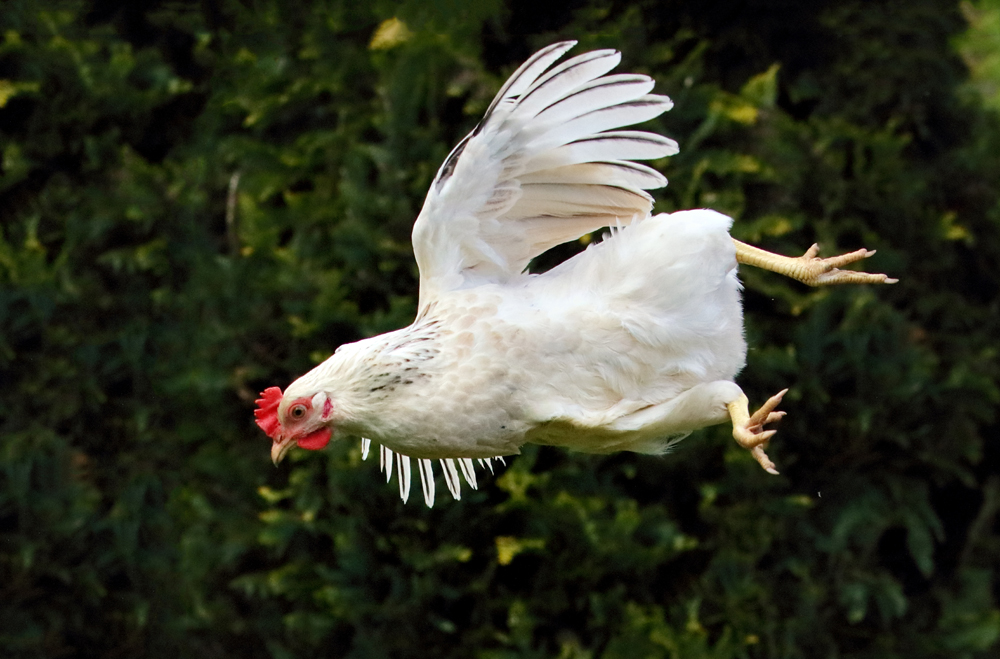
Many biologists are able to look at an animal, living or dead, and learn how it works. In previous decades, this ability was acquired in whole dissections of rats, frogs and earthworms.
These days, students have legitimate concerns about whether it’s right to kill animals solely to take them apart and study them. Fewer dissections are performed in schools, and they rarely involve whole animals – instead, individual organs such as the heart are used. At the same time, meat is increasingly sold pre-prepared and packaged to minimise handling or processing in the kitchen. Many children don’t grow up watching their parents handling meat or preparing whole chickens, rabbits or other animals in the kitchen. Consequently, today’s students approach dissection with less experience and a more profound feeling of squeamishness than ever before.
Nevertheless, the land vertebrate most commonly sold for food in a nearly complete state is probably the chicken, and it is therefore the livestock most familiar to students. Even without its internal organs, the chicken provides an excellent introduction to dissection.
The flight muscles of birds
The flight of birds has always fascinated humans. Our arms have the same sets of bones and we share many of the same muscles as birds, yet we can only flap our arms and imagine ourselves flying. Leonardo da Vinci, for example, was fascinated by the possibility of human mechanical flight and had a lifelong passion for studying the flight of birds and the mechanical workings of the human body. He produced countless annotated sketches of the shoulders and arms of humans and how they attach to the torso. Yet when he studied the structure of a bird wing, he drew it only as far as the shoulder joint. By not investigating the connections of the wing to the muscles that make it flap, he seems to have stopped just when things got interesting.
The primary purpose of this activity is to show the two main muscles of the wing-flapping mechanism of birds and demonstrate how they work. It is perhaps surprising that although the structure of chicken wings and the muscles that make them flap are familiar to almost anyone who is not a vegetarian, people rarely make the connection between the two because the wings and the breast are often eaten separately. The secondary purpose of this activity is to familiarise students with the process and scientific value of dissections in general – that dissections are key to understanding how living things function.
The activity could be used in a biology lesson on bird flight or animal locomotion or related to a physics lesson on forces. It could also support a lesson on evolution – the reason birds’ wings are so similar in structure to our arms – or on model organisms, including how chickens can be used to investigate human limb developmentw1.
Depending on the age or ability of the students, teachers can either perform the dissection or encourage the students to do it for themselves.
Materials
- A plucked chicken (see below)
- A sharp knife or scalpel
- A bamboo or metal kebab skewer
- Gloves
The more complete the chicken, the more interesting the demonstration. In some European countries, plucked chickens are readily available from supermarkets with the head, neck, feet and internal organs (giblets) intact. Teachers can extend this demonstration to other organ systems as desired. Alternatively, a wrapped supermarket chicken as sold in the UK without feet, neck or giblets is perfectly adequate for the demonstration as described here. Teachers may choose to buy organic or free-range chickens.
Safety note
This demonstration carries risks associated with the bacteria found on raw poultry such as salmonella and listeria, as well as with sharp knives or scalpels. Teachers should follow their local health and safety rules. Gloves should be worn to reduce the risk of contamination but are not a substitute for thorough washing of hands afterwards. See also the general safety note.
Method
- Before you start the dissection, identify the homologies (similarities based on descent from a common ancestor) between the chicken’s wings and the human arm. Students will see the similarities between the features in humans – the single bone (humerus) in the upper arm, the elbow, the two bones (radius and ulna) in the forearm, the multi-boned wrist, and the hand with the thumb – and their counterparts in the chicken wing (figure 1).

L Shyamal / Wikimedia Commons
- Extend the wing by inserting a skewer (figure 2). This keeps the arrangement of the wing bones approximately as they would be in flight. We also attached a feather to the skewer to show the wingspan of the chicken. Explain to the students that in humans, the muscles moving the arms in a ‘downstroke’ motion are the pectoralis (or chest) muscles, while the ‘upstroke’ muscles are on the back. In a bird, both sets of muscles are in the chest. The muscles are easily identified, even in supermarket chicken breast fillets – the downstroke muscle is the larger pectoralis muscle on the outside, while the upstroke muscle is the supracoracoideus on the inside (figure 3). This smaller muscle is often sold as a ‘mini fillet’ in the UK or ‘aiguillete’ in France (figure 4). The antagonistic action of these two muscles on the wing (one muscle opposes the action of the other) will be demonstrated later.
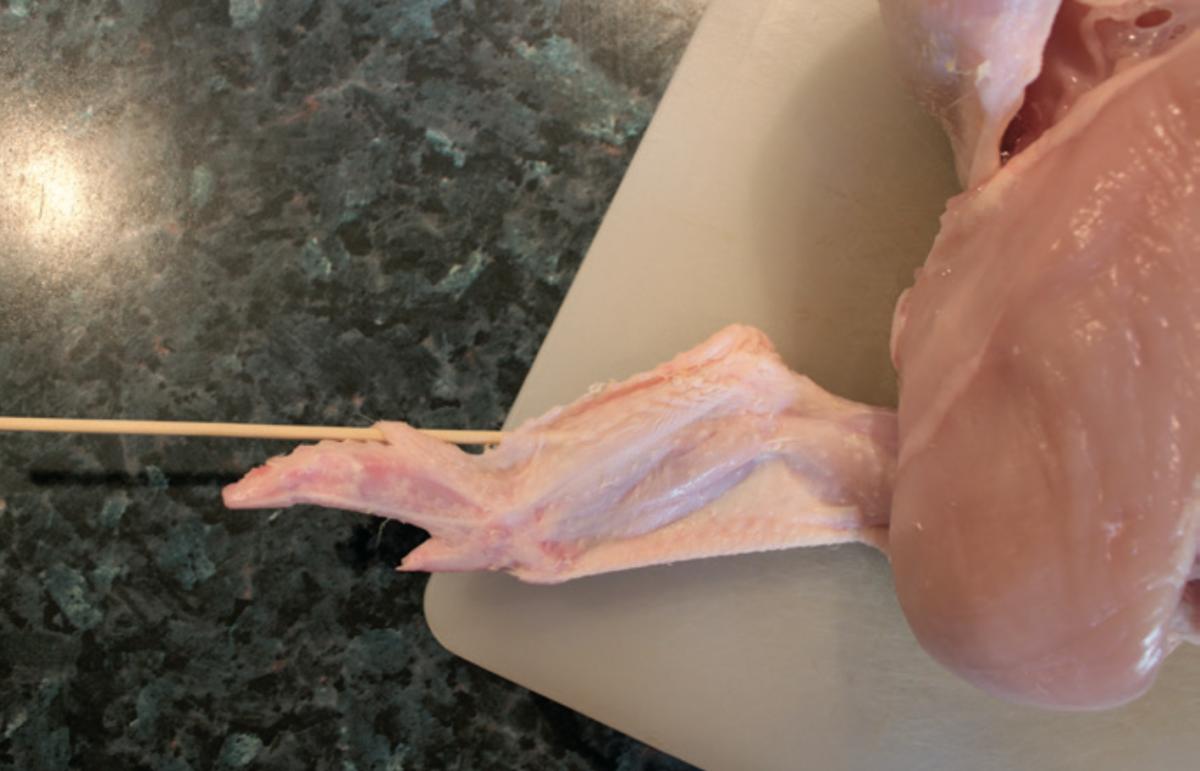
Edmond Hui
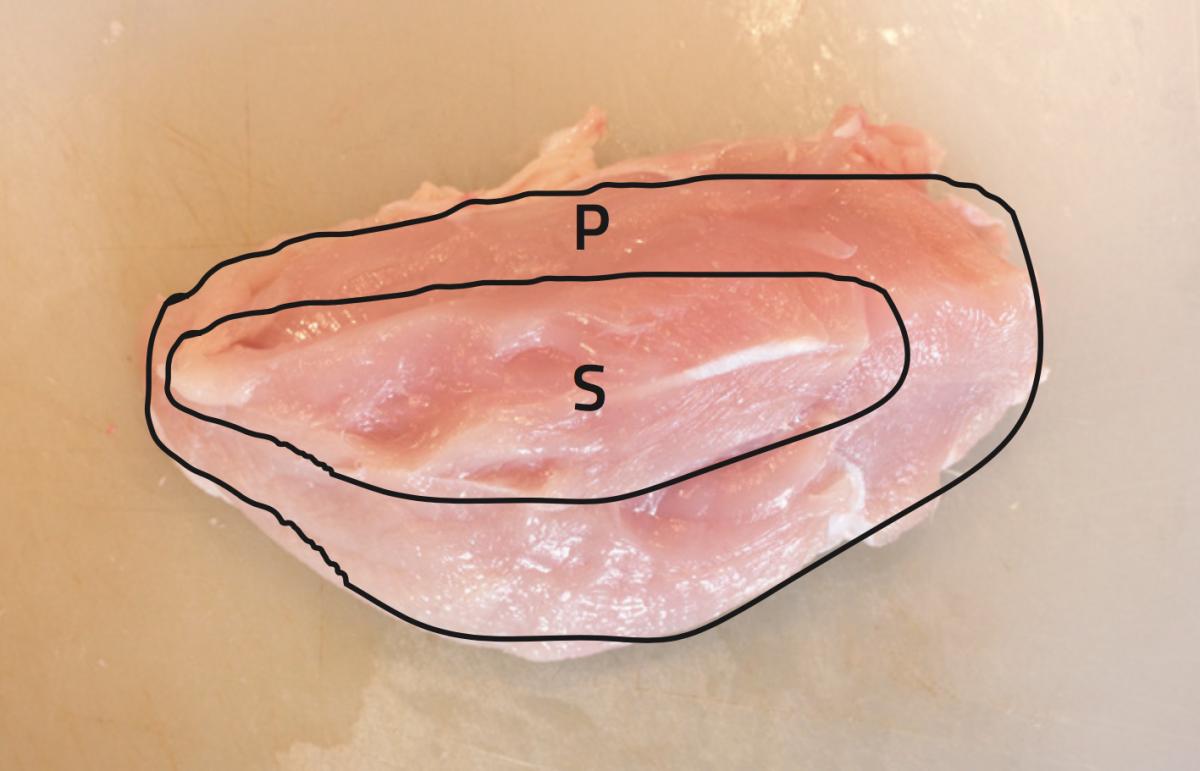
Edmond Hui
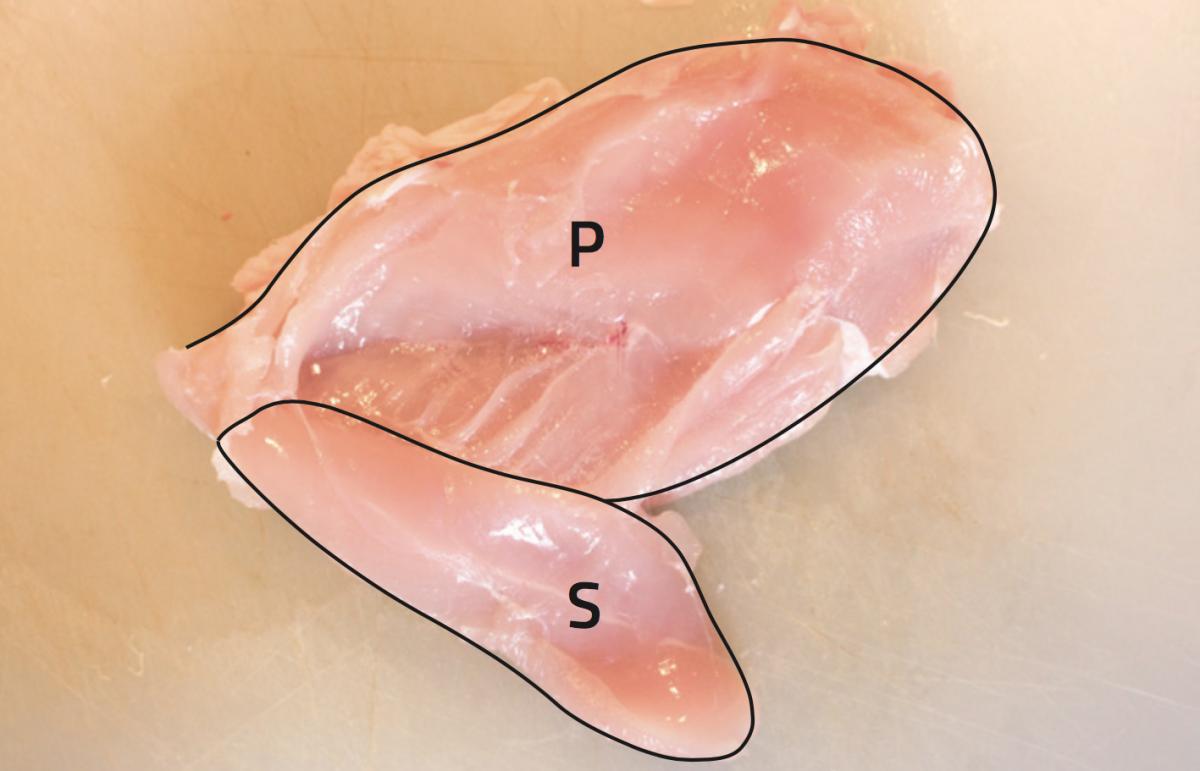
Edmond Hui
- Remove the skin from the breast of the chicken (figure 5). Identify the left pectoralis muscle (this is easier if the demonstrator is right-handed). Note that it is attached not only to the keel of the sternum, but also dorsally to part of the rib structure and anteriorly to the clavicle (or ‘wishbone’) (figure 1).
- Using the knife, carefully separate the pectoralis muscle from the sternum, ribs and clavicle, taking particular care near the anterior end (figure 6). Leave the muscle attached to the humerus. Note that pulling on the pectoralis moves the wing in a downstroke.
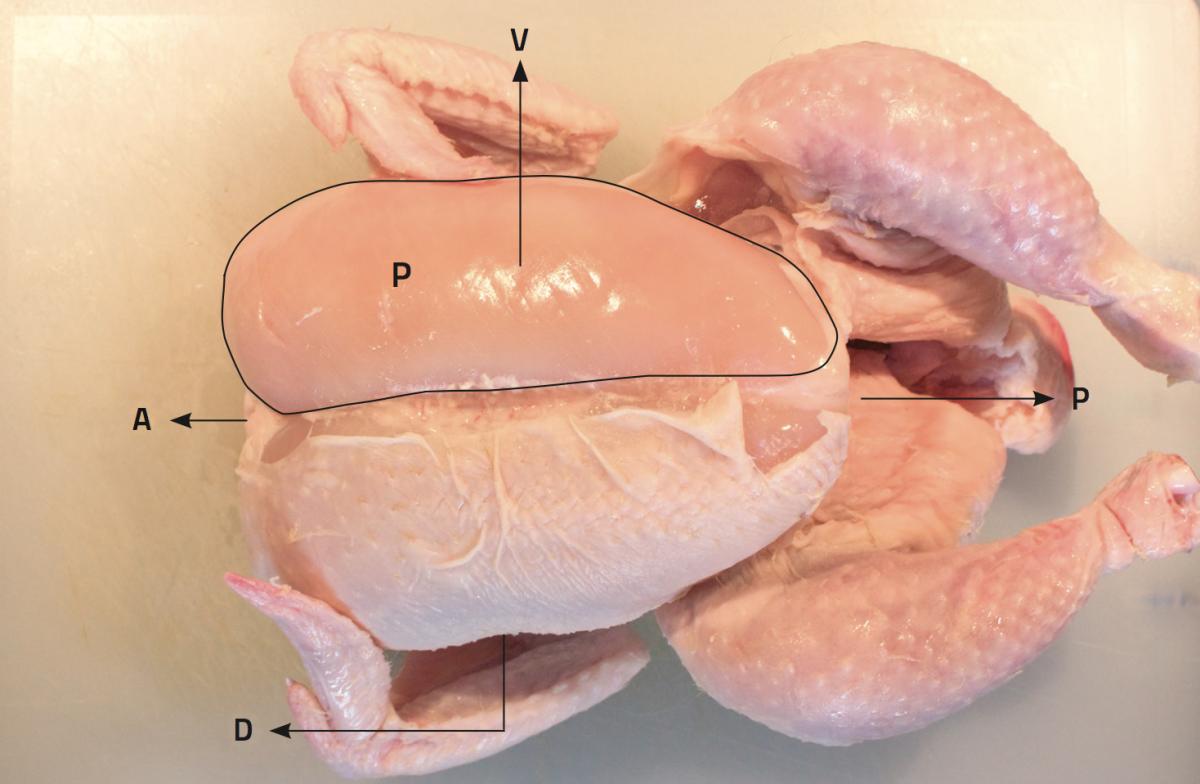
Edmond Hui
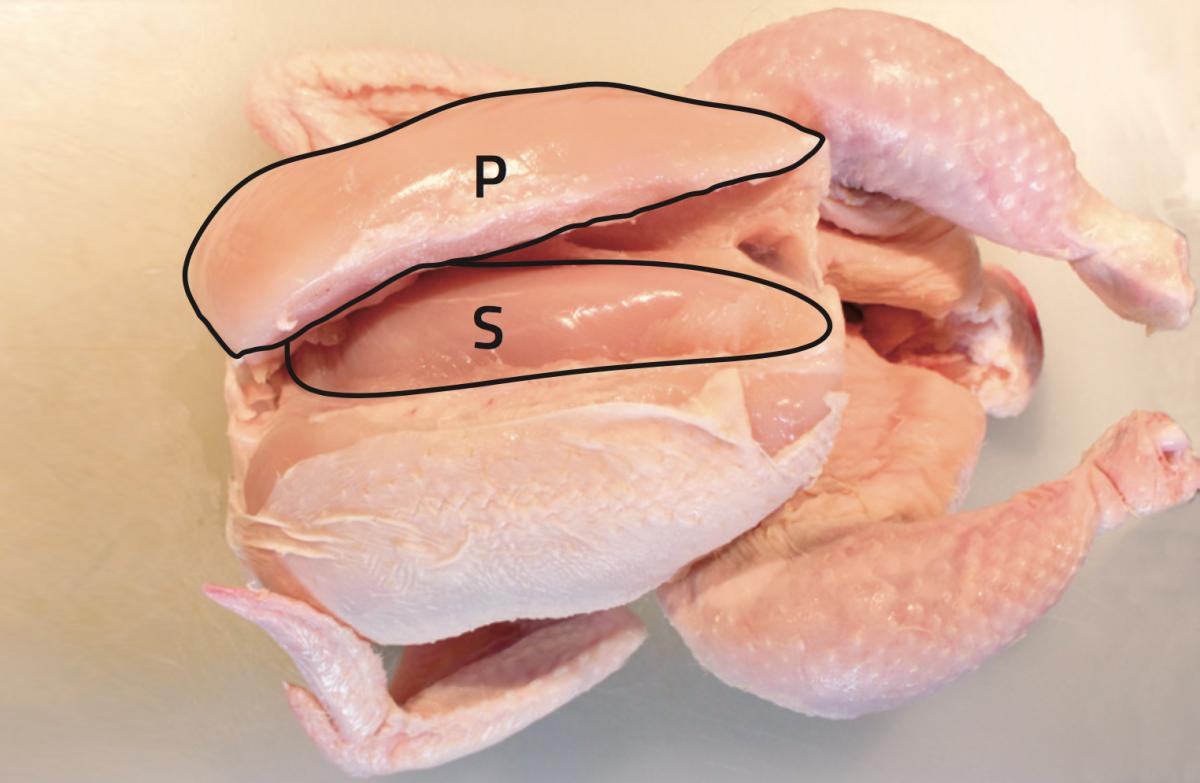
Edmond Hui
- Flip the pectoralis over (figure 7) and separate the supracoracoideus from the sternum (figure 8), noting that it terminates in a tendon that disappears anteriorly under the coracoid bone (figure 9). Explain that this tendon is inserted dorsally into the humerus, having passed around a ‘pulley’ or curved channel in the coracoid bone.

Edmond Hui
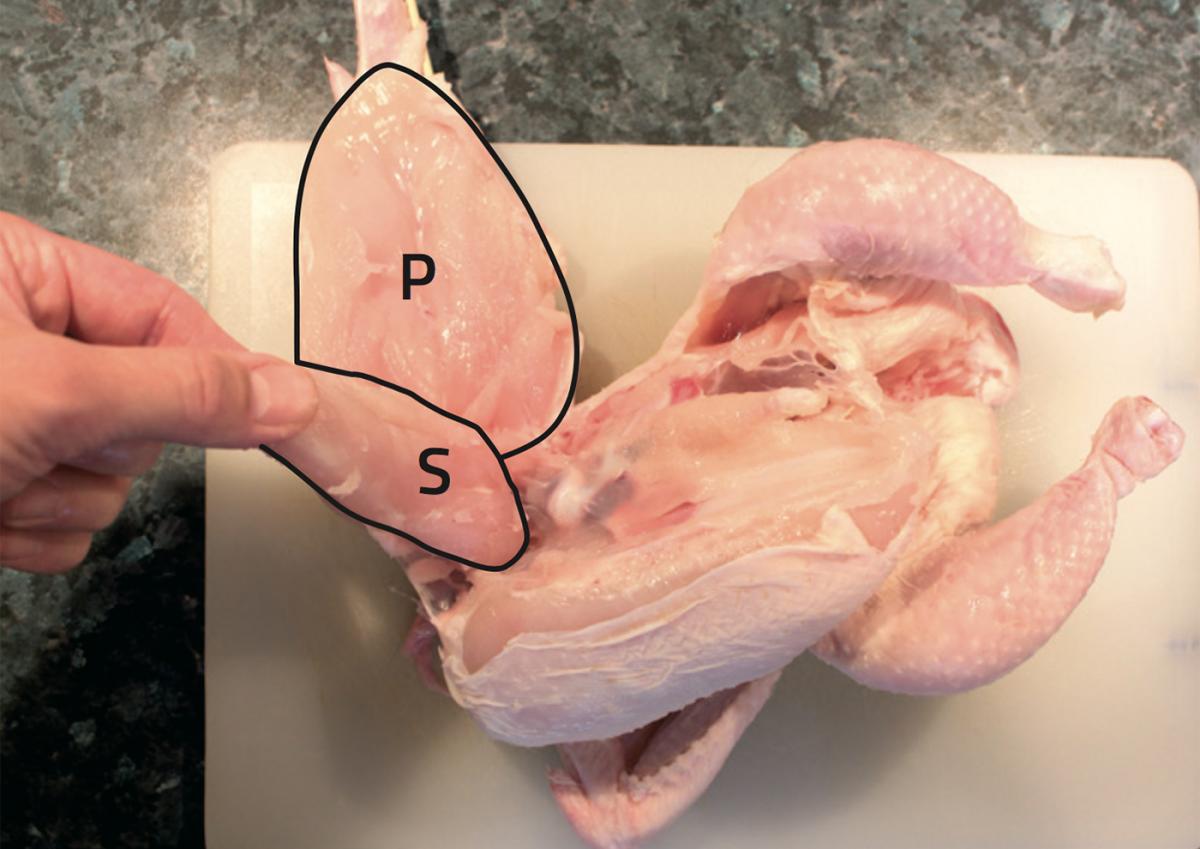
Edmond Hui
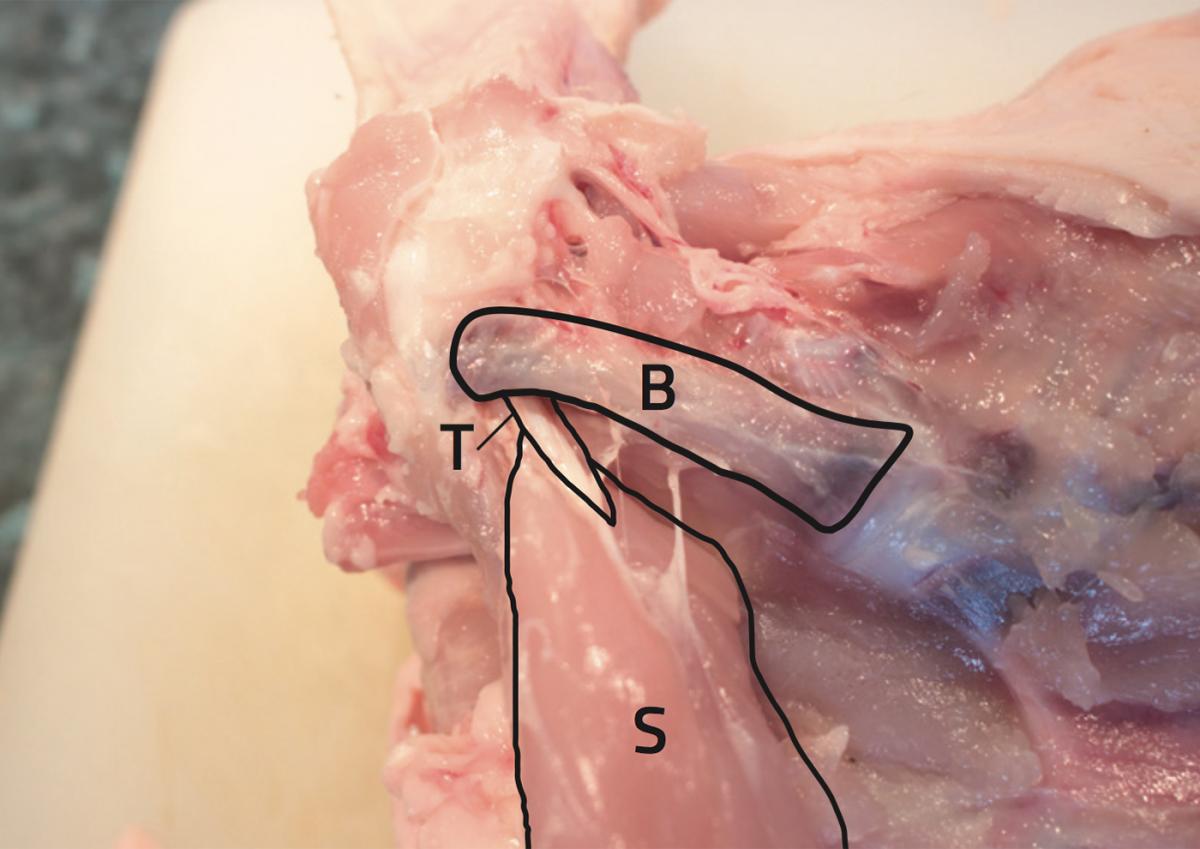
Edmond Hui
- Hold the pectoralis muscle in the left hand and the supracoracoideus muscle in the right (figure 10). Use the heel of the right hand to pin the chicken to the table. Pull the pectoralis in a ventral direction and note that the wing performs a downstroke. Pull the supracoracoideus ventrally and note that the wing performs an upstroke (figure 11). With a little practice, the two muscles can be pulled alternately and rhythmically to produce a continuous flapping motion in the wing (see the video below).
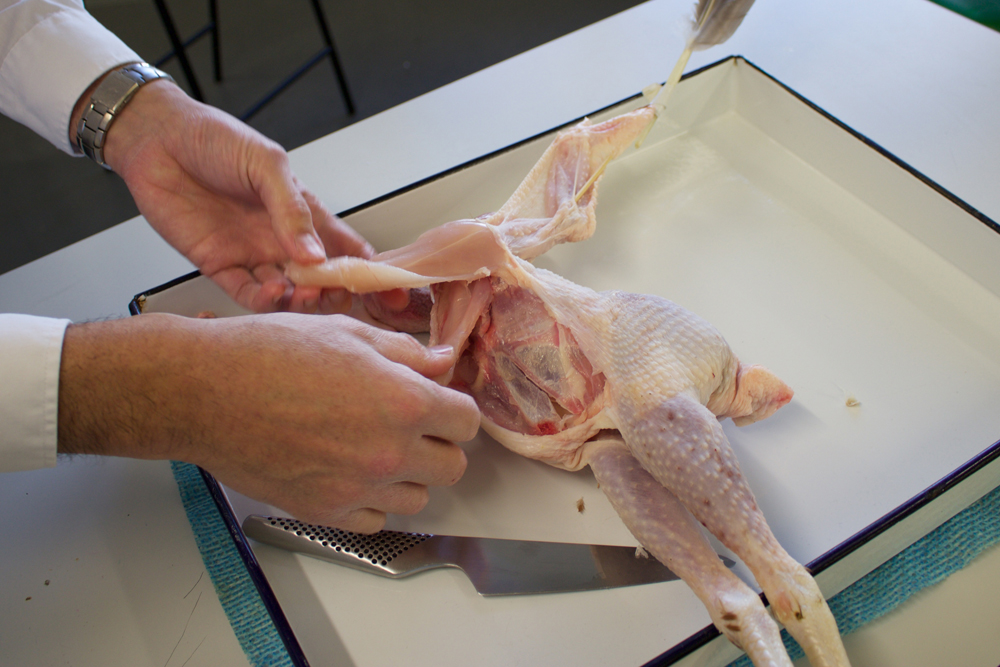
Edmond Hui, Faye Blackshaw, Alma Talbot

Edmond Hui, Faye Blackshaw, Alma Talbot
The students should be given an opportunity to try this – by pulling on the pectoralis and supracoracoideus muscles, they will appreciate the amount of force that is needed to flap the wings during flight. It’s also remarkable to see that the muscles that move the wing upwards and downwards are both located below the wing. This is counter-intuitive because our human ‘upstroke’ muscles are on our back, not our chest.
Extension activities
The dissection can be extended to any other parts of the chicken, depending on the completeness of the bird. For example:
- Remove the pectoralis muscle completely and trace the path of the supracoracoideus tendon around the shoulder joint, pointing out the ‘pulley’ or channel in which the tendon runs (figure 12).
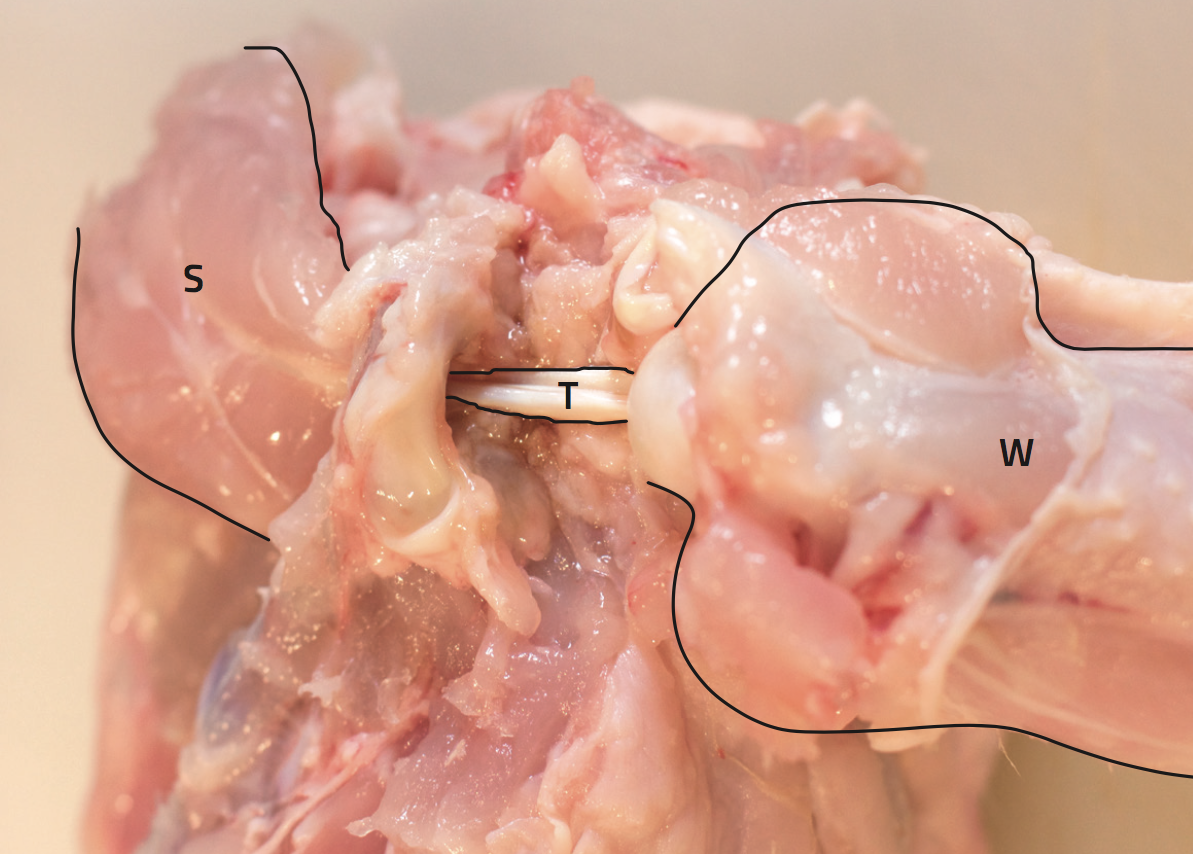
Edmond Hui
- Remove the pectoralis and supracoracoideus muscles and weigh them individually. The ratio of their masses, which is about 5:1 for most birds (Biewener, 2011), gives an estimate of the relative forces required to move the wing downwards and upwards. The pectoralis of one of our specimens weighed 200 g, and the supracoracoideus 45 g, giving a ratio of 4.44:1. We would expect the ratio to reflect the flight habits of the respective species, with atypical birds that generate considerable lift on the upstroke – such as hummingbirds– having smaller ratios; and faster flying migratory birds that use aerodynamic forces to aid the upstroke – such as waterfowl – to have higher ratios.
Point out that there is a continuous seal around the supracoracoideus – it is in a cavity enclosed entirely by the pectoralis and sternum. Usually, antagonistic muscles are located on opposite sides of the joint that they act upon. The arrangement of both muscles being on the same side in birds, with one muscle wrapped around and fully enclosing its antagonist, is unusual. It would be interesting to discover whether this morphology exists elsewhere in the animal kingdom.
- If the chicken has intact legs, the same style of investigation can be used to demonstrate the muscles and tendons of the leg, which can flex and extend the foot and the claws (figure 13). Note the remarkably smooth and slippery nature of the cartilage of the joints, and point out the importance of reducing friction in these articulations.
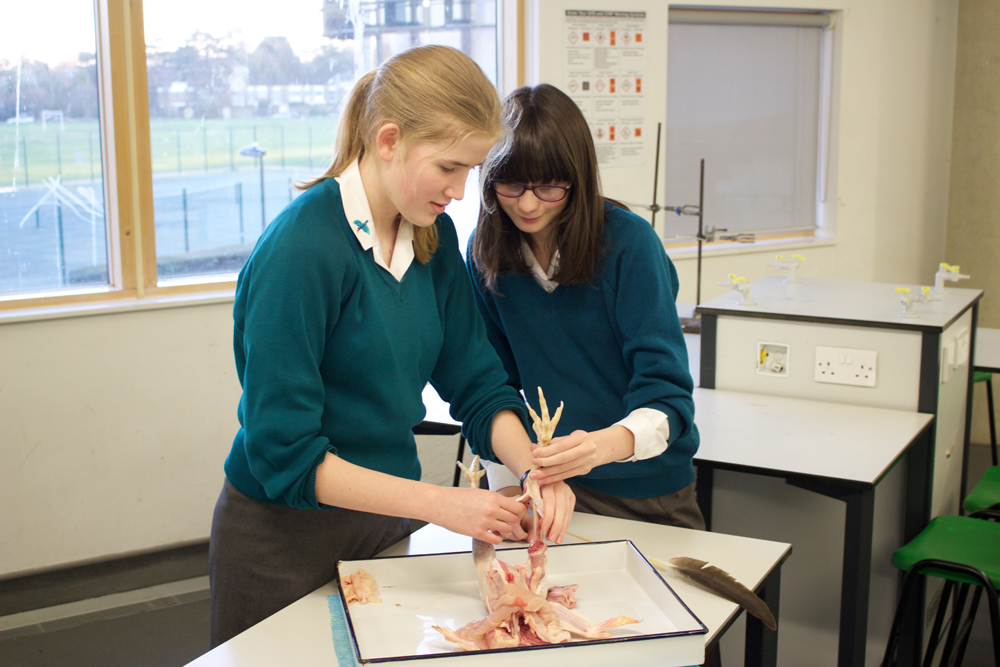
Edmond Hui
Conclusion
This demonstration is an opportunity to achieve three objectives with one bird.
- Using a familiar supermarket chicken alleviates some of the logistical, cultural and psychological pressures that lead to a reduction in school dissections, while still yielding real anatomical information.
- By simply pulling on the chicken’s breast muscles, students see the action of antagonistic muscles to flex and extend vertebrate limbs, which is part of many standard biology curricula.
- Attempting to answer questions such as ‘how does a chicken flap its wings?’ or ‘what is the role of a chicken’s breast?’ allows students to experience perhaps the most difficult part of science to teach – the act of discovery. They will almost certainly be surprised to discover not only that the chicken breast they eat is responsible for the bird’s flapping strokes, but also that they can demonstrate this themselves.
References
- Biewener A (2011) Muscle function in avian flight: achieving power and control. Philosophical Transactions of the Royal Society B 366: 1496-1506. doi: 10.1098/rstb.2010.0353
- Hui E, Taplin A (2013) From the bottom of our hearts: a hands-on demonstration of the mammalian heartbeat. Science in School 27: 20-25.
Web References
- w1 – Megan Davey explains in a video how she investigates the development of the human hand using chickens as a genetic model.
Resources
- A video of the flight muscles of snow geese could be used to support the activity, particularly if a dissection at school is not feasible.
Review
This article about the anatomy and physiology of bird wings and how they function is a wonderful opportunity to lighten up early science teaching. Young students are keen to explore and come to their own conclusions; a chicken dissection is perfect.
The hands-on approach, in contrast to learning from anatomical drawings presented in textbooks, will boost students’ learning and memory. Comparing bird anatomy to our own anatomy may lead to some fun, and also to speculation about why humans cannot fly. Students of all ages could create labelled sketches of the bird’s anatomy – similar to da Vinci’s, but now including the shoulder! Older students could dig deeper into the physiology of wing movements using anatomical charts of different birds – especially flightless birds.
If the dissection is done in a food technology room rather than a science laboratory, you can cook and eat the chicken afterwards. This highlights the knowledge to be gained by paying attention to everyday habits – meat-eating students might eat chicken breasts on a fairly regular basis, but it’s unlikely that they will ever have stopped to consider the function of the muscles they are eating. Be prepared for the question ‘how was this chicken killed?’, which may arise particularly from non-meat-eating students, and always perform a professional dissection to show respect for the animal.
There is also plenty of room for discussion about:
- Differences in wing anatomy of various birds
- Flying patterns in different birds and how they affect anatomy
- Muscle weight and how this reflects function
- Differences in dark and white meat.
Friedlinde Krotscheck, secondary-school biology teacher (retired), Austria





